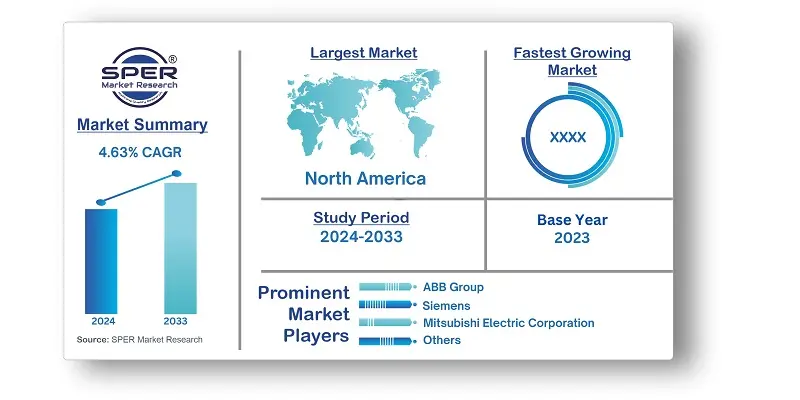
Railway Traction Motor Market Trends, Share, Size, Revenue, Competition and Future Outlook
Railway Traction Motor Market Growth, Size, Trends Analysis- By Type, By Application- Regional Outlook, Competitive Strategies and Segment Forecast to 2033
| Published: Nov-2024 | Report ID: AMIN24236 | Pages: 1 - 248 | Formats*: |
| Category : Automotive & Transportation | |||
- July 2022: Mahle created an electric traction motor that may be used in construction tractors and equipment as well as commercial vehicles. This traction motor provides excellent performance and works continuously. It is a revolutionary cooling concept that has enabled this technical leap.
- April 2022: ABB India disclosed that it is constructing a specialised facility to produce 1,500 traction motors. These will supply vital propulsion systems required for other locomotives and metro rail projects in Gujarat, India.


| Report Metric | Details |
| Market size available for years | 2020-2033 |
| Base year considered | 2023 |
| Forecast period | 2024-2033 |
| Segments covered | By Type, By Application. |
| Regions covered | North America, Asia-Pacific, Latin America, Middle East & Africa and Europe. |
| Companies Covered | ABB Group, ALSTOM, BHEL, Bombardier, Hyundai Rotem Company, Mitsubishi Electric Corporation, Saini Group, Siemens, Sulzer Ltd, Others. |
- Railway Equipment Manufacturers
- Railway Operators
- Urban Transport Authorities
- Government and Regulatory Bodies
- Traction Motor Manufacturers
- Public and Private Investors
- Consulting and Engineering Firms
- Renewable Energy and Sustainability Experts
- Research and Development Institutes
- Maintenance and Service Providers
| By Type: | |
| By Application: |
- Global Railway Traction Motor Market Size (FY’2024-FY’2033)
- Overview of Global Railway Traction Motor Market
- Segmentation of Global Railway Traction Motor Market By Type (DC Traction Motor, AC Traction Motor, Synchronous AC Traction Motor)
- Segmentation of Global Railway Traction Motor Market By Application (Diesel Locomotive, Electric Multiple Units, Electric Locomotives, Diesel-Electric Locomotives)
- Statistical Snap of Global Railway Traction Motor Market
- Expansion Analysis of Global Railway Traction Motor Market
- Problems and Obstacles in Global Railway Traction Motor Market
- Competitive Landscape in the Global Railway Traction Motor Market
- Impact of COVID-19 and Demonetization on Global Railway Traction Motor Market
- Details on Current Investment in Global Railway Traction Motor Market
- Competitive Analysis of Global Railway Traction Motor Market
- Prominent Players in the Global Railway Traction Motor Market
- SWOT Analysis of Global Railway Traction Motor Market
- Global Railway Traction Motor Market Future Outlook and Projections (FY’2024-FY’2033)
- Recommendations from Analyst
1.1. Scope of the report1.2. Market segment analysis
2.1. Research data source
2.1.1. Secondary Data2.1.2. Primary Data2.1.3. SPERs internal database2.1.4. Premium insight from KOLs
2.2. Market size estimation
2.2.1. Top-down and Bottom-up approach
2.3. Data triangulation
4.1. Driver, Restraint, Opportunity and Challenges analysis
4.1.1. Drivers4.1.2. Restraints4.1.3. Opportunities4.1.4. Challenges
4.2. COVID-19 Impacts of the Global Railway Traction Motor Market.
5.1. SWOT Analysis
5.1.1. Strengths5.1.2. Weaknesses5.1.3. Opportunities5.1.4. Threats
5.2. PESTEL Analysis
5.2.1. Political Landscape5.2.2. Economic Landscape5.2.3. Social Landscape5.2.4. Technological Landscape5.2.5. Environmental Landscape5.2.6. Legal Landscape
5.3. PORTERs Five Forces
5.3.1. Bargaining power of suppliers5.3.2. Bargaining power of buyers5.3.3. Threat of Substitute5.3.4. Threat of new entrant5.3.5. Competitive rivalry
5.4. Heat Map Analysis
6.1. Global Railway Traction Motor Market Manufacturing Base Distribution, Sales Area, Product Type6.2. Mergers & Acquisitions, Partnerships, Product Launch, and Collaboration in Global Railway Traction Motor Market
7.1. Global Railway Traction Motor Market Size, Share and Forecast, By Type, 2020-20267.2. Global Railway Traction Motor Market Size, Share and Forecast, By Type, 2027-20337.3. DC Traction Motor7.4. AC Traction Motor7.5. Synchronous AC Traction Motor
8.1. Global Railway Traction Motor Market Size, Share and Forecast, By Application, 2020-20268.2. Global Railway Traction Motor Market Size, Share and Forecast, By Application, 2027-20338.3. Diesel Locomotive8.4. Electric Multiple Units8.5. Electric Locomotives8.6. Diesel-Electric Locomotives
9.1. Global Railway Traction Motor Market Size and Market Share
10.1. Global Railway Traction Motor Market Size and Market Share By Region (2020-2026)10.2. Global Railway Traction Motor Market Size and Market Share By Region (2027-2033)10.3. Asia-Pacific
10.3.1. Australia10.3.2. China10.3.3. India10.3.4. Japan10.3.5. South Korea10.3.6. Rest of Asia-Pacific
10.4. Europe
10.4.1. France10.4.2. Germany10.4.3. Italy10.4.4. Spain10.4.5. United Kingdom10.4.6. Rest of Europe
10.5. Middle East and Africa
10.5.1. Kingdom of Saudi Arabia10.5.2. United Arab Emirates10.5.3. Qatar10.5.4. South Africa10.5.5. Egypt10.5.6. Morocco10.5.7. Nigeria10.5.8. Rest of Middle-East and Africa
10.6. North America
10.6.1. Canada10.6.2. Mexico10.6.3. United States
10.7. Latin America
10.7.1. Argentina10.7.2. Brazil10.7.3. Rest of Latin America
11.1. ABB Group
11.1.1. Company details11.1.2. Financial outlook11.1.3. Product summary11.1.4. Recent developments
11.2. ALSTOM
11.2.1. Company details11.2.2. Financial outlook11.2.3. Product summary11.2.4. Recent developments
11.3. BHEL
11.3.1. Company details11.3.2. Financial outlook11.3.3. Product summary11.3.4. Recent developments
11.4. Bombardier
11.4.1. Company details11.4.2. Financial outlook11.4.3. Product summary11.4.4. Recent developments
11.5. Hyundai Rotem Company
11.5.1. Company details11.5.2. Financial outlook11.5.3. Product summary11.5.4. Recent developments
11.6. Mitsubishi Electric Corporation
11.6.1. Company details11.6.2. Financial outlook11.6.3. Product summary11.6.4. Recent developments
11.7. Saini Group
11.7.1. Company details11.7.2. Financial outlook11.7.3. Product summary11.7.4. Recent developments
11.8. Siemens
11.8.1. Company details11.8.2. Financial outlook11.8.3. Product summary11.8.4. Recent developments
11.9. Sulzer Ltd
11.9.1. Company details11.9.2. Financial outlook11.9.3. Product summary11.9.4. Recent developments
11.10. Others
SPER Market Research’s methodology uses great emphasis on primary research to ensure that the market intelligence insights are up to date, reliable and accurate. Primary interviews are done with players involved in each phase of a supply chain to analyze the market forecasting. The secondary research method is used to help you fully understand how the future markets and the spending patterns look likes.
The report is based on in-depth qualitative and quantitative analysis of the Product Market. The quantitative analysis involves the application of various projection and sampling techniques. The qualitative analysis involves primary interviews, surveys, and vendor briefings. The data gathered as a result of these processes are validated through experts opinion. Our research methodology entails an ideal mixture of primary and secondary initiatives.



Frequently Asked Questions About This Report
PLACE AN ORDER
Year End Discount
Sample Report
Pre-Purchase Inquiry
NEED CUSTOMIZATION?
Request CustomizationCALL OR EMAIL US
100% Secure Payment






Related Reports
Our Global Clients
Our data-driven insights have influenced the strategy of 200+ reputed companies across the globe.






















